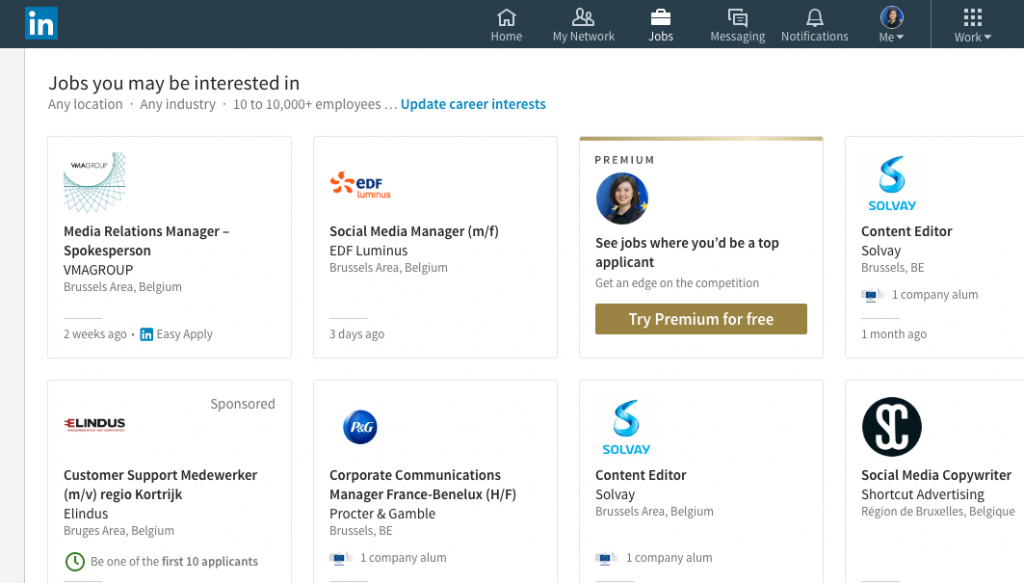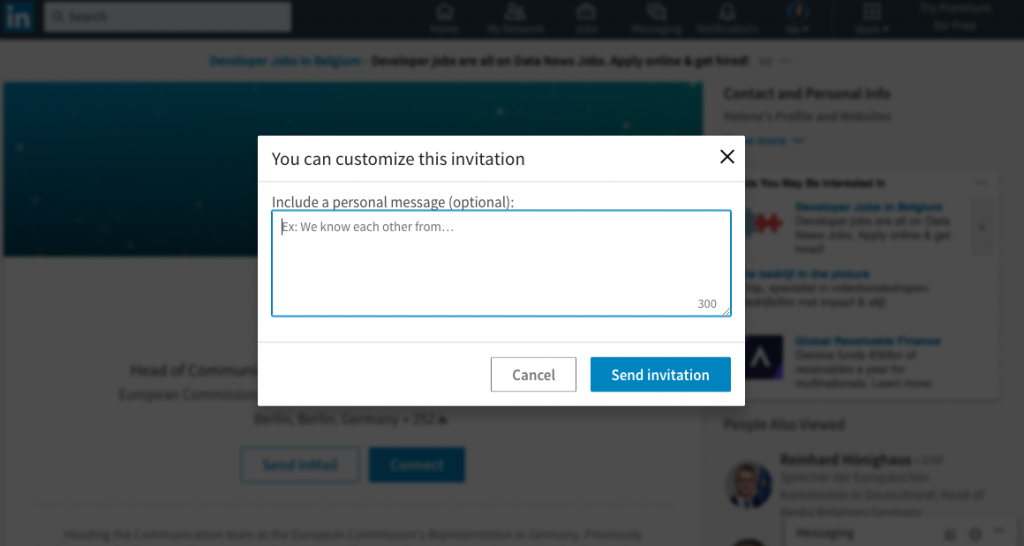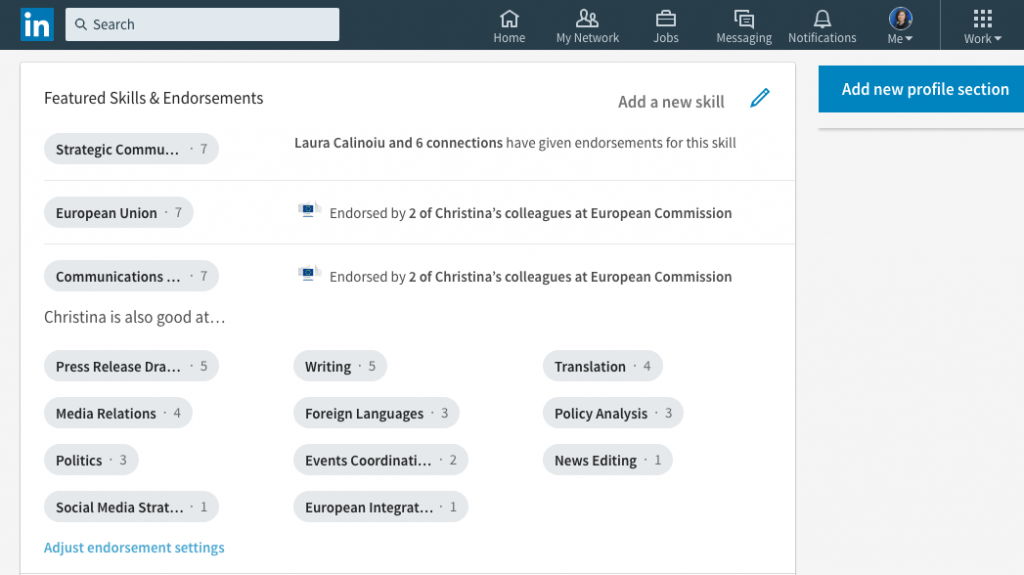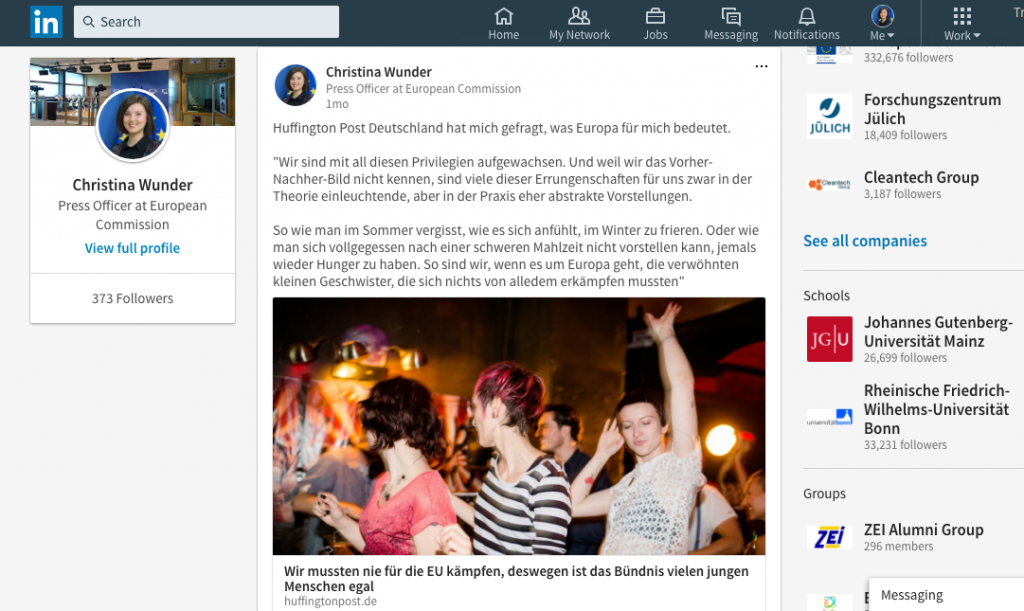Job hunting via LinkedIn? 10 tips for young professionals
When I first signed up for LinkedIn – I believe it was towards the end of my Bachelors degree – I didn’t really know why I was doing this, I mean, what I would use it for. In my eyes it was yet another social platform, that I would have to maintain and update. The mere thought of it was exhausting me already.
But in the end I thought: whatever, there’s no harm in giving it a try, is there? Some of my friends from University already had profiles, so at least I wouldn’t have zero contacts, but rather… well, three. And with time, my profile evolved, and I gained not only new contacts and additional milestones on my CV, but today I even owe my present job to this portal. My current employer had stumbled upon my page – and then offered me a job.
In this article I put together some recommendations that could help you to create and polish your LinkedIn presence – in 10 easy-to-follow steps.
#1 Number one: just start already
Most of the readers of this blog will already have mastered this one. Congratulations! If not, what are you waiting for?
Even if you’re still at university, don’t hesitate to get the ball rolling on your LinkedIn profile. Needless to say, one should be able to find your profile by searching for your real name. A protected account which is only be visible for you and your friends may be useful for Instagram if you want to protect your privacy. But on LinkedIn that more or less defeats the purpose. Firstly, you wantto be found, and secondly you’d be sharing exclusively things that would make you look good professionally, right?
#2 What do you write? Reflect on your professional experience so far (even if it’s not a lot yet)
Back then, for me this was one of the main advantages of my new social media toy: I was forced to review my almost non-existent career and think about all the things I’ve done so far, what I was proud of and how I could present it in the best way possible.
When it comes my studies, what do I want to highlight, in order to try and impress someone? What have I achieved, professionally? My first reflex was to say: well, nothing, I’m only just studying! But after giving it some proper thought, I realised that I had indeed already done and achieved a couple of things that I could be proud of.
Sit down for an afternoon and write down all the things that you have done professionally. Maybe you could do that together with a friend? A well-meaning second opinion can work wonders sometimes.
A fair amount of stalking is allowed, too: browse through some other people’s profiles, including those that are in a similar situation as you. When you see what other students or young professionals are bragging about, it can remind you of one or another activity that you had almost forgotten about. This could be anything from summer jobs over volunteer activities to internships – anything that is remotely related to your “professional you”. Did you participate in any competitions? Any programmes, scholarships, study visits abroad? Especially when you’re at the beginning of your career and don’t have so many things to show off with, include whatever you can.
Are you member of some network, an organisation or a local non-profit? Add it in and describe your role in it. If that organisation has a LinkedIn-group, join it. Did you publish any academic papers during your studies? Did you write for your university newspaper? Put it all in.
All these things are not simply filling the emptiness in your yet-to-mature career path. They also show that you are interested and competent to do things. And, very importantly, these little tricks of the trade can help you to become more confident with what you have done so far, as well as to get a better feel for what is relevant for your career path and how to present it in the best possible way.
#3 How do you name your various milestones?
Only because you were an “intern in unit 3.24b“, and that’s what is indicated in your work contract, it doesn’t mean that you have to describe it like this. Unless you wantto prevent people from understanding what it is that you do.
Obviously: lying is a no-go. But still, there are many ways to describe your position and tasks in a more understandable way. When I was filling my empty LinkedIn-profile for the first time, I was a student at university – fair enough. But I was also doing some freelance translation jobs on the side from time to time. Therefore, it was not a lie to call myself a freelance translator, as well as student right? (Even if the good old impostor-syndrome made me feel slightly uncomfortable with it, but I simply had to get over that).
You could do the same if you are for example volunteering in some NGO or doing jobs on the side on a freelance basis. Moreover, providing more than one “position” at the same time is perfectly acceptable.
Another example: when talking about their traineeship, many of my friends simply put “intern” and the company’s name, and leave it there. While this may be factually correct, it remains incredibly vague about what you actually did. As far as this description is concerned, your tasks and responsibilities could have ranged from making coffee all day or taking care of entire operations all by yourself – who could tell? We all know perfectly well that all too often, interns are used as cheap and docile workers. Which is why it is all the more important to choose a description for your experience, which explains in the best possible way what your actual tasks and responsibilities were.
For instance, halfway through one of my traineeships, I eventually had to de-facto replace a colleague, who was out for several months. My job title, as defined by my contract, remained unchanged, but my actual duties had evolved massively. Therefore, changing my LinkedIn-description to “Press assistant (trainee)” is no less factually correct than “intern” – yet it looks more impressive and represents my tasks better. You could also chose to name your department, e.g. “Information and media (trainee) or “Trainee in the controlling department of XYZ”, etc. There’s no strict rules really, as long as it reflects the truth and provides a hint about what you have been actually doing there.
#4 List your tasks and responsibilities
Whichever experience you list, make sure to make use of the description box. Give the person looking at your profile a chance to better understand your role and concrete tasks. An example from my work experience would be: drafting press material, organising press conferences, briefing journalists, etc. etc. By naming some typical duties, you are showing that you are indeed familiar with these tasks, should a potential employer look for someone to do just that for them. You could also name the kinds of tools and programmes that you have used there, if that is relevant in your sector. One advantage that young professionals tend to have over their more experienced and older counterparts, is that they excel at digital skills. Make sure to let people know about that.
Further, what kinds of projects have you taken ownership for? Which topics have you worked on in greater detail? If it helps to describe your professional experience, use it.
#5 Dress for the job you want, not for the one you have
Sure, we all have to do different tasks in parallel. Some of them we like doing, some of them we hate. When describing your professional experience, you should primarily name the ones that you like doing, and of which you would like to do even more in your future job. When somebody is browsing through LinkedIn for potential staff to hire, they may type in certain keywords, for example “controlling”, “website maintenance” or “events organisation”. If you are currently doing a bit of all of these, but want to never waste a single second of your life with controlling – leave it out.
If instead, you are sometimes organising events, but feel like this is what you would want to be doing all day long, make sure this is included in your description.
The same holds true for your city of residence:
If currently you are living in Brussels, but would like to move to Berlin, I recommend you to change your city of residence to the latter. This way you will firstly receive vacancy recommendations for your preferred city and secondly, employers who are hiring will potentially see your profile when looking for suitable people in that area.

#6 Who should you connect with?
This one is very simple: with as many people as possible – provided that you actually know them (or have a good reason to contact them even though you don’t know them).
Start with people from your school or university. The friend you beat at beer-pong today could be the HR-person of the company you’re trying to get in to tomorrow. I’m not saying you should suck up to everyone you meet, just in case you might need their help later. But loosely keeping in touch won’t do any harm and allows you to stay up-to-date on who is where. In the best case it can even help in unforeseen ways, like learning about vacancies earlier because one of your contacts posted it, etc. During any internship or job you should definitely connect with colleagues, bosses or business partners there. Sticking around in people’s list of LinkedIn connections can help them to remember you. Sometimes people need new staff at very short notice – it is not unheard of that they are willing to recruit people from their existing pool of contacts, such as former trainees and the like.
You may also want to connect with people you meet at conferences or other events, if, say, you had an interesting conversation with them. Maybe you shared some interests, or that person works in a company or an sector you are very interested in? Try to talk to them and then connect via LinkedIn to stay in touch.
Very importantly though: when adding them, do leave a short note saying who you are and where you met – not everyone is super good with remembering names and faces, and you don’t want to confuse people and have them ignore you.

#7 Skills & Endorsements
On LinkedIn you have the possibility to compliment people for their competencies or leave a short message stating how they excelled at this or the other. This is not a must, but there’s no harm in endorsing a couple of friends or colleagues for their skills – they may return the favour.
Think about which skills are important for your preferred career path and ask a couple of friends to endorse you for these. Firstly, this way the box will not be completely empty any more, and secondly, should anyone search for these keywords, your profile might even show up.

#8 And now, post until you drop?
With all the social media profiles that I have to maintain, I hardly manage to stay up-to-date on all of them, let alone to post interesting and intelligent contributions all the time. However, should you have the energy and motivation for it, it is indeed a fine opportunity to let people know what you care about and how you get involved. The same goes for articles that you write. Make sure to let your network know about them.

#9 LinkedIn-Hygiene – update it from time to time
As time (and your career) progresses, new milestones and experiences will add to your CV. Updating this whenever something changes in your professional life really doesn’t take long. A new traineeship, a new NGO you joined, a new job you started or a new language you are learning. Just add it in. It’s not complicated, it just needs to be done.
Sometimes when I speak to people about LinkedIn and the like, they share their bad conscience: “Oh boy, I really should have a look at my profile and update it”. This makes it sound like a whole lot of work, but it really isn’t. At the very least, your given position on LinkedIn should reflect the actual job that you’re currently doing.
#10 So, why should I be doing all of this?
Whether you want to find your next dream job via LinkedIn or not – you should probably put some thinking into your digital profile beforeyou desperately need it.
I was very satisfied with my previous job. And even if I somewhat knew that I wouldn’t stay there forever, I wasn’t actively looking for something new. But my LinkedIn profile had different plans for me, and was working behind the scenes to get me hired in Brussels.
It came totally out of the blue, when I received that email from a former colleague. We had never worked with each other directly, but I had added him on LinkedIn when I was a trainee there back in 2013. “We’re looking for people like you”, he wrote. “If you’re interested, feel free to send me your CV. What do you say?”
I say: Seriously, investing a little bit of energy in your LinkedIn profile is totally worth it.
What about you?
Are you maintaining your digital profile with care? Did you ever use it to hunt for jobs?
Do you have any other recommendations that I missed here? Let me know!



